To master your perfect cup of tea, you'll need to understand precise water temperatures for each variety. Delicate teas like white and green require cooler water (160-180°F), while robust black and herbal teas can handle higher temps (200-212°F). Use a variable temperature kettle or thermometer for accuracy. Steep times also matter: 1-3 minutes for green teas, 2-5 for oolongs, and 3-5 for black teas. Remember to preheat your teaware and adjust for altitude if necessary. By controlling these factors, you'll reveal the full potential of your tea's flavor profile. There's even more to explore in the world of precision tea brewing.
Understanding Tea Temperature Basics
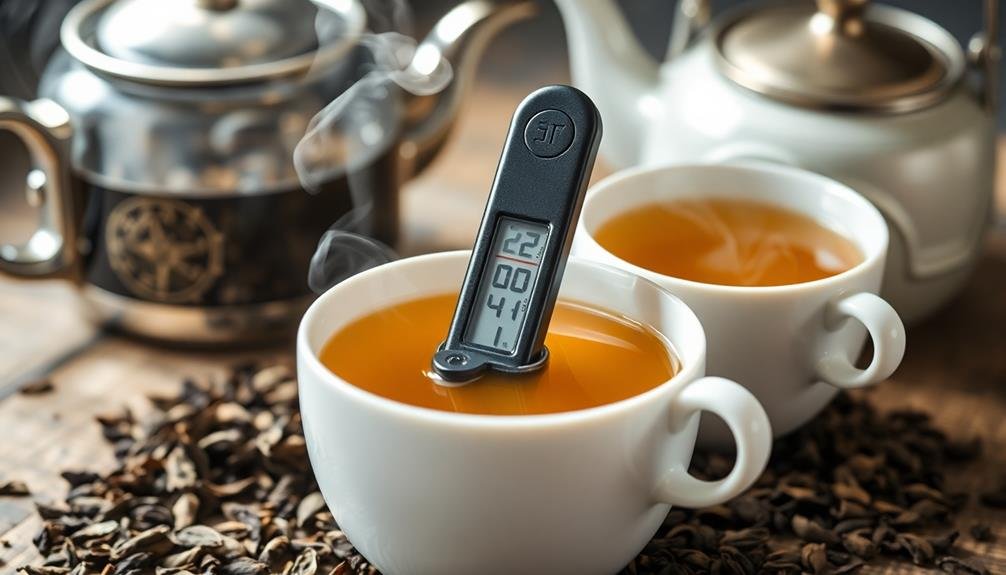
For the perfect cup of tea, temperature is key. Different tea types require specific water temperatures to extract ideal flavor and avoid bitterness. Generally, delicate teas like white and green need cooler water, while robust black teas can handle higher temperatures.
White and green teas thrive in water between 160°F to 180°F (71°C to 82°C). This range preserves their subtle flavors and prevents scorching.
Oolong teas prefer slightly hotter water, around 180°F to 190°F (82°C to 88°C), to reveal their complex profiles. Black teas and herbal infusions can withstand near-boiling water at 200°F to 212°F (93°C to 100°C).
To achieve these temperatures, you've got options. Use a variable temperature kettle for precise control, or let boiling water cool for a few minutes before pouring over delicate teas. A food thermometer can help you gauge temperature accurately.
Remember, these are guidelines; adjust based on personal preference and specific tea instructions.
Consistently using the right water temperature will dramatically improve your tea-drinking experience, allowing you to fully appreciate the nuances of each blend you brew.
Types of Tea Thermometers
With the right temperature being essential for brewing tea, various types of tea thermometers can help you achieve precision. Digital thermometers offer quick, accurate readings and often come with preset temperature settings for different tea types. Infrared thermometers provide contactless temperature measurement, ideal for checking the water in your kettle without opening it. Analog thermometers, while slower, are reliable and don't require batteries. Some kettles come with built-in thermometers, combining heating and temperature monitoring in one device.
When choosing a tea thermometer, consider these factors:
- Accuracy: Look for thermometers with a margin of error of ±1°F or less.
- Response time: Faster readings help you catch the perfect temperature.
- Ease of use: Clear displays and intuitive controls make brewing easier.
- Durability: Choose thermometers that can withstand frequent use and occasional drops.
You'll find that investing in a quality tea thermometer elevates your brewing experience. It takes the guesswork out of temperature control, allowing you to consistently create the perfect cup of tea.
Whether you prefer digital precision or the classic look of an analog thermometer, there's an option to suit your needs and brewing style.
Ideal Temperatures for Different Teas
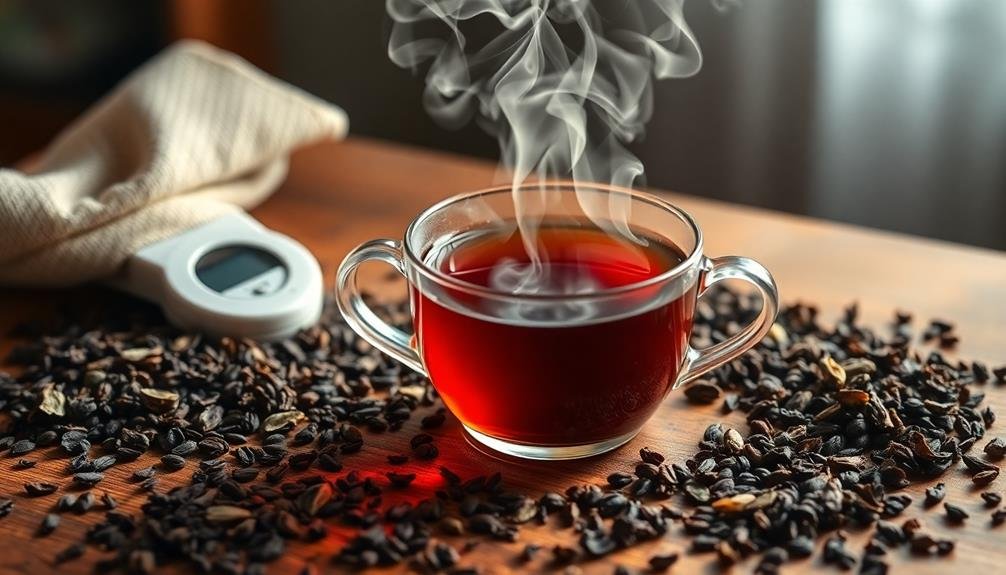
You'll find that different teas require specific temperatures for ideal flavor extraction.
For green tea, aim for a water temperature between 150°F and 180°F (65°C to 82°C) to avoid bitterness and preserve its delicate taste.
When brewing black tea, you'll want hotter water, typically in the range of 200°F to 212°F (93°C to 100°C), to fully release its robust flavors.
Green Tea Temperature Range
The ideal temperature range for brewing green tea is essential for extracting its delicate flavors without introducing bitterness. Generally, you'll want to keep your water temperature between 160°F and 180°F (71°C to 82°C) for most green teas. This lower temperature prevents the leaves from releasing too many tannins, which can result in an astringent taste.
Japanese green teas, like Sencha or Gyokuro, often benefit from slightly cooler water, around 160°F to 170°F (71°C to 77°C).
Chinese green teas, such as Dragonwell or Gunpowder, can handle slightly higher temperatures, typically 170°F to 180°F (77°C to 82°C).
To achieve the perfect temperature for your green tea:
- Use a thermometer for precise measurements
- Let boiling water cool for 2-3 minutes before pouring
- Invest in a variable temperature kettle for convenience
- Pre-warm your teapot or cup to maintain the ideal temperature
Black Tea Brewing Heat
Unlike green tea, black tea thrives in hotter water, allowing its robust flavors to fully develop. For most black teas, you'll want to aim for a water temperature between 200°F and 212°F (93°C to 100°C). This higher heat helps extract the bold, full-bodied flavors and tannins characteristic of black tea.
If you're brewing a delicate black tea like a first flush Darjeeling, you might want to dial back the temperature slightly to around 195°F (90°C) to preserve its nuanced flavors. For stronger black teas like Assam or Ceylon, you can confidently use water right off the boil at 212°F (100°C).
Remember that brewing time is just as vital as temperature. Most black teas steep best for 3 to 5 minutes. Oversteeping can lead to bitterness, so keep an eye on the clock. If you prefer a stronger brew, it's better to add more tea leaves rather than extending the steeping time.
Using the right temperature for black tea guarantees you'll extract the perfect balance of flavor, aroma, and caffeine. Don't be afraid to experiment within this range to find your ideal cup.
White Tea Temperature Guide
Generally, white tea requires a delicate touch when it comes to brewing temperature. You'll want to aim for a lower temperature range compared to other tea types to preserve its subtle flavors and avoid bitterness. The ideal temperature for white tea typically falls between 160°F and 185°F (71°C to 85°C).
To achieve the perfect cup of white tea, consider these temperature guidelines:
- Silver Needle: 160°F – 170°F (71°C – 77°C)
- White Peony: 170°F – 175°F (77°C – 79°C)
- Shou Mei: 175°F – 180°F (79°C – 82°C)
- Gongmei: 180°F – 185°F (82°C – 85°C)
If you don't have a thermometer, you can estimate the temperature by bringing water to a boil and then letting it cool for about 2-3 minutes. This should bring the water to the appropriate range for most white teas.
Green Tea Temperature Precision
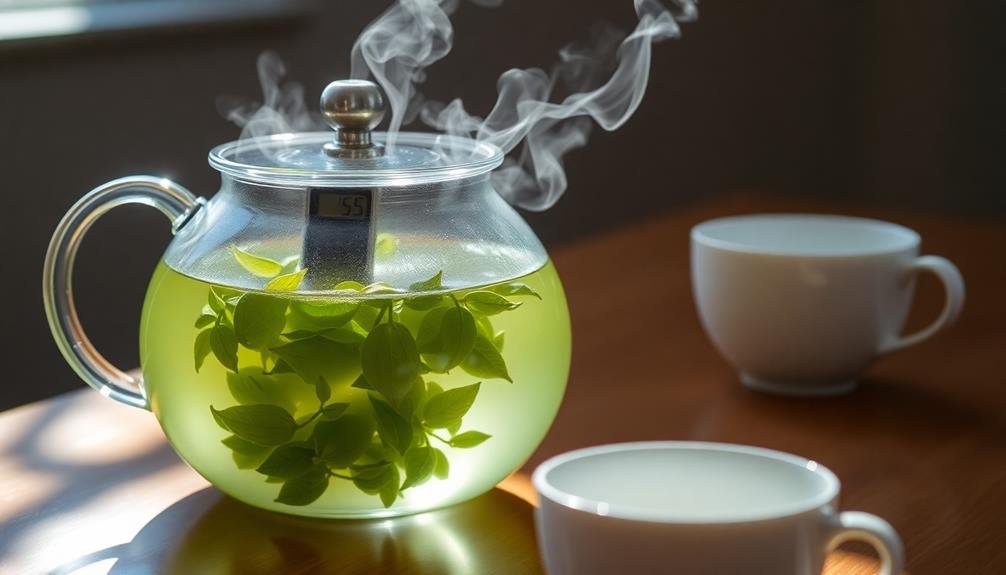
To brew the perfect cup of green tea, you'll need to focus on precise temperature control.
The ideal temperature range for green tea typically falls between 160°F and 180°F (71°C to 82°C), but you can adjust brewing times to fine-tune the flavor.
Using accurate thermometers or temperature-controlled kettles will help you achieve consistent results and master your green tea preparation.
Ideal Temperature Range
Precision is key when brewing the perfect cup of green tea. The ideal temperature range for green tea typically falls between 160°F and 180°F (71°C to 82°C). This range allows for superior flavor extraction without releasing excessive bitterness or astringency from the delicate leaves.
You'll want to aim for the lower end of this spectrum for more delicate green teas and the higher end for heartier varieties.
To achieve the perfect temperature, you can use a variable temperature kettle or a thermometer. If you don't have these tools, here's a quick guide to estimate water temperature:
- Boil water and let it cool for 2-3 minutes (175°F-180°F)
- Allow water to cool for 3-4 minutes (170°F-175°F)
- Wait 4-5 minutes after boiling (160°F-170°F)
- Let water cool for 5-6 minutes (150°F-160°F)
Brewing Time Adjustments
Once you've nailed the ideal water temperature, it's time to focus on brewing time. For green tea, precision in steeping duration is essential to avoid bitterness and achieve the best flavor. Generally, you'll want to brew green tea for 1-3 minutes, but this can vary depending on the specific variety and your personal taste preferences.
Start with a shorter brewing time of about 1 minute for delicate green teas like Gyokuro or Shincha. For more robust varieties like Sencha or Dragonwell, you can extend the steeping time to 2-3 minutes. If you're using tea bags, stick to the lower end of the range, as the tea leaves are usually finer and release flavor more quickly.
Pay attention to the color and aroma of your tea as it steeps. When it reaches a pale yellow-green hue and releases a fresh, grassy scent, it's likely ready.
To fine-tune your brewing time, experiment with 30-second increments until you find your sweet spot. Remember, you can always add more steeping time, but you can't undo over-brewed tea. Trust your palate and adjust accordingly for your perfect cup.
Equipment for Precision
Several tools can help you achieve the perfect temperature for brewing green tea. A digital thermometer is crucial for precise readings, allowing you to measure water temperature accurately.
Electric kettles with temperature control settings offer convenience and consistency, letting you select the ideal temperature for green tea with just a push of a button.
For those who prefer a more traditional approach, a stovetop kettle with a built-in thermometer can be an excellent choice. It combines the charm of a classic kettle with the precision of modern temperature measurement.
If you're looking for a budget-friendly option, temperature-sensitive stickers can be applied to your existing kettle, changing color to indicate when the water reaches the desired temperature.
To guarantee you're brewing your green tea at the perfect temperature, consider these key points:
- Green tea typically requires water between 160°F and 180°F (71°C to 82°C)
- Lower temperatures preserve delicate flavors and prevent bitterness
- Different green tea varieties may have specific ideal brewing temperatures
- Consistency in water temperature leads to more predictable and enjoyable results
Oolong Tea Temperature Sweet Spot
The perfect temperature for brewing oolong tea falls within a narrow range of 180-190°F (82-88°C). This sweet spot allows you to extract the complex flavors and aromas characteristic of oolong without over-extracting bitter compounds. To achieve this precision, use a thermometer or an electric kettle with temperature control.
If you're using a regular kettle, bring the water to a boil, then let it cool for about 2-3 minutes before pouring. For more accuracy, transfer the water to a separate vessel and monitor its temperature as it cools.
Remember that oolong teas can vary in oxidation levels, so you may need to adjust within this range. Lightly oxidized oolongs benefit from temperatures closer to 180°F, while darker oolongs can handle up to 190°F. Experiment within this range to find your preferred taste.
Steep time is equally important; start with 2-3 minutes for lighter oolongs and 3-5 minutes for darker varieties. As you become more familiar with your chosen oolong, you'll be able to fine-tune both temperature and steeping time to create your perfect cup.
Black Tea Temperature Perfection
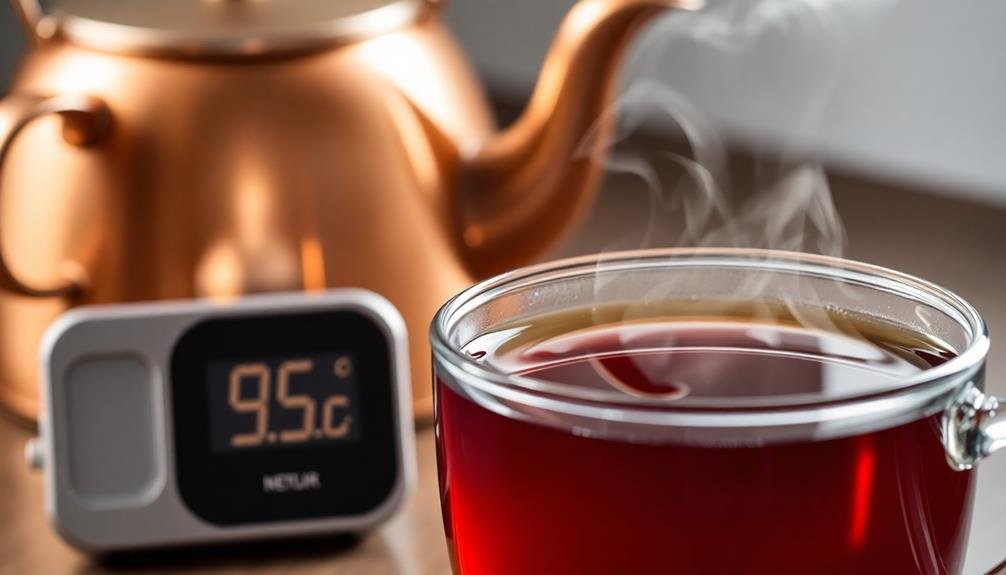
When brewing black tea, you'll want to hit the sweet spot for temperature and steeping time.
For most black teas, aim for water between 200°F to 212°F (93°C to 100°C) to extract the full flavor profile.
You can steep your black tea for 3 to 5 minutes, adjusting the time based on your preferred strength and the specific tea variety.
Ideal Temperature Range
To achieve the perfect cup of black tea, you'll need to nail the ideal water temperature. The best range for brewing black tea typically falls between 90°C to 96°C (194°F to 205°F). This temperature range allows for proper extraction of the tea's flavors and aromas without causing bitterness or astringency.
Water that's too hot can over-extract the tea, resulting in a harsh, bitter taste. Conversely, water that's too cool won't extract enough flavor, leaving you with a weak, underwhelming brew.
To guarantee you're hitting the sweet spot, consider these key points:
- Use a thermometer for precise temperature control
- Let boiling water cool for 30-60 seconds before pouring
- Invest in a temperature-controlled electric kettle
- Preheat your teapot or mug to maintain the ideal temperature
Remember that different black tea varieties may have slight variations in their ideal brewing temperatures. For example, delicate Darjeeling teas might benefit from slightly cooler water, while robust Assam teas can handle higher temperatures.
Experiment within the recommended range to find your perfect balance, and you'll be well on your way to mastering the art of brewing black tea.
Steeping Time Recommendations
Perfecting your steeping time is essential for achieving the ideal cup of black tea. The duration you allow your tea to steep greatly impacts its flavor, strength, and overall quality. Generally, black tea requires 3-5 minutes of steeping time, but this can vary depending on the specific variety and your personal preferences.
For a more precise approach, consider the following steeping time recommendations:
| Tea Type | Loose Leaf | Tea Bag |
|---|---|---|
| Light Black | 2-3 minutes | 1-2 minutes |
| Medium Black | 3-4 minutes | 2-3 minutes |
| Strong Black | 4-5 minutes | 3-4 minutes |
Start with these guidelines and adjust according to your taste. If you prefer a stronger brew, steep for the longer duration within each range. For a milder flavor, opt for the shorter end. Remember that over-steeping can lead to bitterness, while under-steeping may result in a weak, unsatisfying cup.
To guarantee consistency, use a timer and pay attention to how different steeping times affect your tea's taste. You'll soon discover your perfect balance, allowing you to replicate your ideal cup of black tea with precision every time.
Herbal Tea Temperature Recommendations
Release the full potential of your herbal tea by brewing it at the right temperature. Unlike traditional teas, herbal infusions don't contain actual tea leaves, so they're more forgiving when it comes to water temperature.
However, to extract the best flavors and benefits, you'll want to use water that's just off the boil, around 200°F to 212°F (93°C to 100°C).
For most herbal teas, including chamomile, peppermint, and rooibos, you can pour boiling water directly over the herbs. This high temperature helps release the essential oils and compounds that give herbal teas their unique flavors and health benefits.
Some delicate herbs, like lemon balm or verbena, might benefit from slightly cooler water, around 190°F (88°C), to prevent bitterness.
Here's a quick guide for popular herbal teas:
- Chamomile: 200°F (93°C)
- Peppermint: 212°F (100°C)
- Rooibos: 200°F (93°C)
- Hibiscus: 208°F (98°C)
Water Quality and Temperature
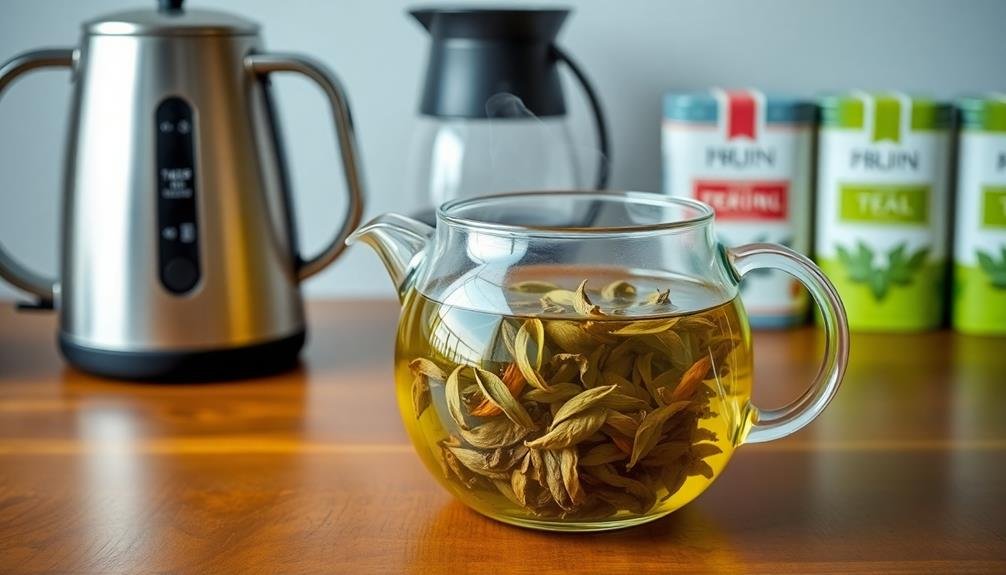
While brewing temperature is key, the quality of your water is equally important for crafting the perfect cup of tea. Start with fresh, cold water that's free from impurities and off-flavors. Filtered or spring water is ideal, as it enhances the tea's natural taste without introducing unwanted minerals or chemicals.
The temperature of your water can make or break your brew. For delicate teas like white and green, aim for water between 160°F and 180°F. This prevents bitterness and allows the subtle flavors to shine.
Black, oolong, and pu-erh teas benefit from hotter water, typically around 190°F to 212°F, which helps extract their robust flavors and aromas.
To achieve precise temperatures, use a variable temperature kettle or a thermometer. If you don't have these tools, you can estimate by letting boiling water cool for 2-3 minutes for black tea, or 5-6 minutes for green tea.
Preheating Your Teaware
A simple yet vital step in brewing the perfect cup of tea is preheating your teaware. This process helps maintain the tea's temperature throughout brewing and serving, ensuring ideal flavor extraction.
To preheat, simply fill your teapot, cup, or mug with hot water and let it sit for a minute before discarding. This warms the vessel, preventing heat loss when you add your tea.
Preheating is particularly important for delicate teas like green or white varieties, which require lower brewing temperatures. It's also important when using ceramic or porcelain teaware, as these materials tend to absorb heat quickly.
Don't skip this step even if you're in a hurry – it only takes a moment and greatly improves your tea experience.
Here's why preheating your teaware matters:
- Maintains consistent brewing temperature
- Enhances flavor extraction
- Prolongs the warmth of your tea
- Prevents thermal shock in delicate teaware
Steeping Time and Temperature Relationship
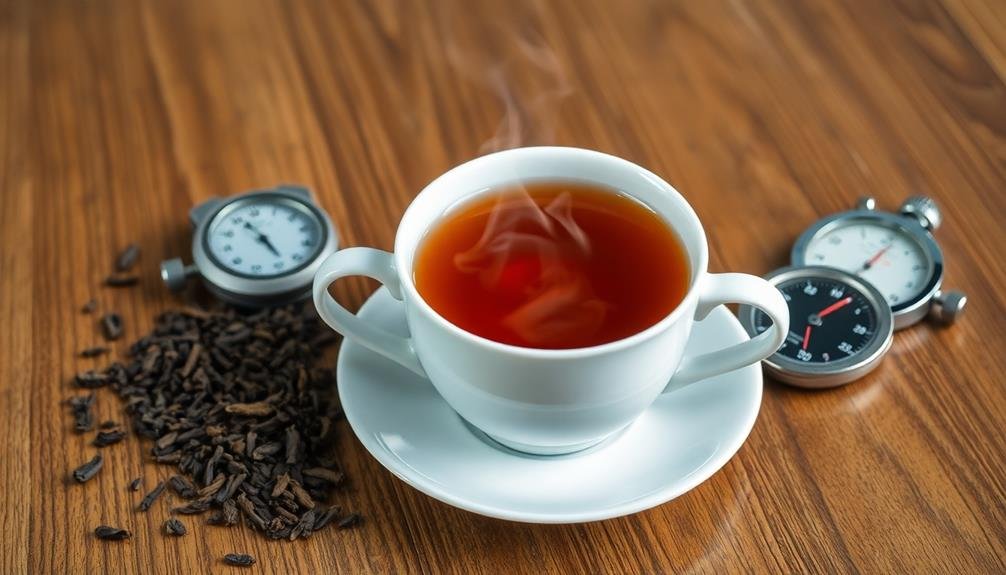
Now that your teaware is preheated, it's time to focus on the intricate dance between steeping time and water temperature.
These two factors are essential in extracting the ideal flavor from your tea leaves. Generally, the higher the water temperature, the shorter the steeping time should be.
For delicate green and white teas, use water around 160-175°F (71-79°C) and steep for 1-3 minutes. This gentle approach preserves their subtle flavors and prevents bitterness.
Oolong teas require slightly hotter water, about 180-190°F (82-88°C), with a steeping time of 2-5 minutes.
Black teas and pu-erh can handle near-boiling water at 200-212°F (93-100°C) and steep for 3-5 minutes.
Adjusting for Altitude
If you're brewing tea at high altitudes, you'll need to adjust your approach. Water boils at a lower temperature as elevation increases, which can greatly impact your tea's flavor and strength. At sea level, water boils at 212°F (100°C), but at 5,000 feet, it boils at just 203°F (95°C). This difference means you'll need to steep your tea for longer to achieve the desired taste.
To compensate for altitude when brewing tea, follow these guidelines:
- Increase steeping time by 30 seconds for every 1,000 feet above sea level.
- Use slightly more tea leaves to enhance flavor extraction.
- Consider using a pressure cooker to raise the boiling point of water.
- Invest in an electric kettle with adjustable temperature settings.
Remember that different tea types react differently to altitude changes. Delicate teas like green and white may require less adjustment, while robust black teas and pu-erh might need more notable modifications.
Experiment with these variables to find the perfect balance for your location. Don't be afraid to tweak your brewing method until you achieve the ideal cup of tea at your altitude.
Maintaining Temperature During Infusion
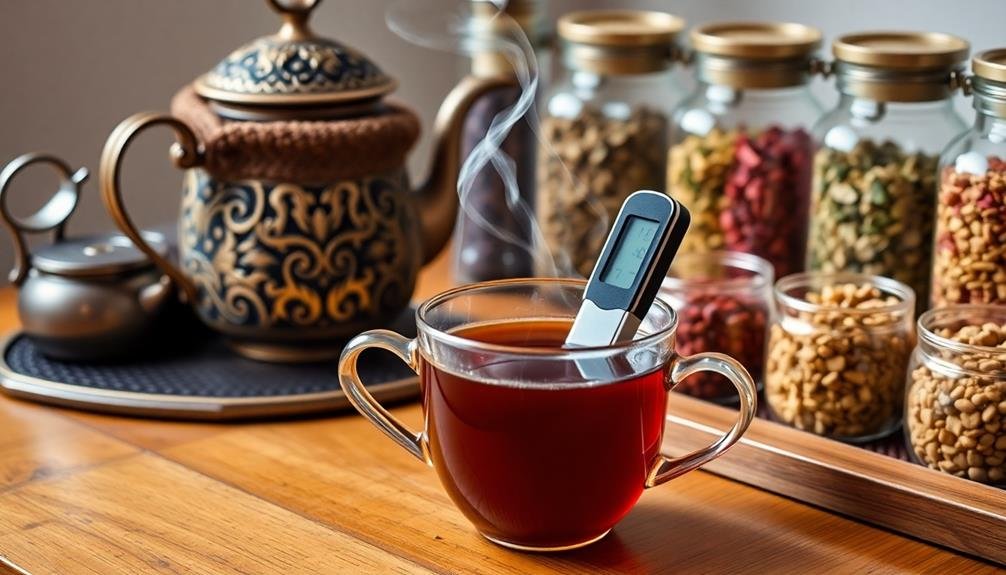
Once you've accounted for altitude and brought your water to the right temperature, keeping it stable during infusion is key to a consistently great cup of tea. To maintain the ideal temperature, consider using a thermal carafe or preheated teapot. These vessels help minimize heat loss during steeping.
If you're using a regular teapot, warm it first by rinsing it with hot water before adding your tea leaves and water.
For precision, invest in a tea thermometer to monitor the water temperature throughout the infusion process. If you notice a significant drop, you can top up with a small amount of hotter water to maintain the desired temperature. However, be cautious not to overheat the tea, as this can lead to bitterness.
Another effective method is to use a tea cozy or insulated tea mug. These accessories provide insulation, keeping your tea at the ideal temperature for longer periods.
For loose leaf teas, consider using a brewing basket that allows for easy removal once the desired steeping time is reached. This prevents over-extraction while maintaining the water temperature for subsequent infusions, especially useful for teas that can be steeped multiple times.
Frequently Asked Questions
Can I Use a Regular Kitchen Thermometer for Measuring Tea Water Temperature?
Yes, you can use a regular kitchen thermometer to measure tea water temperature. It's not ideal, but it'll work in a pinch. For better accuracy, consider investing in a digital thermometer specifically designed for beverages.
How Does Water Temperature Affect Caffeine Content in Brewed Tea?
You'll extract more caffeine with hotter water. Higher temperatures release caffeine faster, so your tea will be stronger. If you're looking for less caffeine, try brewing at lower temperatures or for shorter times.
Are There Smartphone Apps for Precise Tea Temperature Control?
Yes, you'll find several smartphone apps designed for precise tea temperature control. They often work with smart kettles or thermometers, allowing you to set and monitor temperatures. Some even offer timers and brewing guides for different tea types.
Does the Material of the Teapot Affect Water Temperature Retention?
Yes, your teapot's material affects temperature retention. Ceramic and porcelain hold heat well, while glass and metal cool faster. You'll find thicker walls and insulated designs keep your tea hotter longer. Consider these factors when choosing your teapot.
Can I Achieve Proper Tea Temperature Using a Microwave?
While you can use a microwave to heat water, it's not ideal for achieving precise tea temperatures. You'll likely end up with uneven heating and hot spots. It's better to use a kettle for more consistent results.
In Summary
You've now mastered the art of precision tea temperatures. Armed with the right tools and knowledge, you'll consistently brew the perfect cup. Remember, each tea type has its ideal temperature, and factors like altitude can affect your brew. Don't forget to preheat your teaware and maintain the temperature during steeping. With practice, you'll develop an intuitive sense for ideal brewing. Enjoy your perfectly crafted teas, and savor the nuanced flavors you've revealed.





Leave a Reply